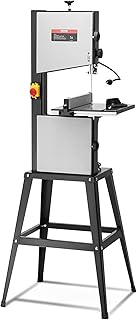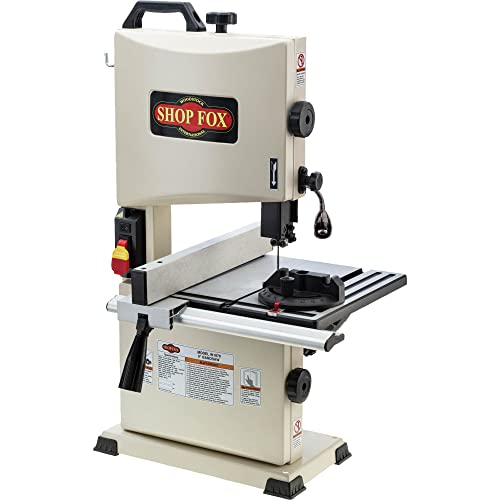When it comes to precision cutting, a 9-inch band saw is often the go-to choice for hobbyists and small workshops. These compact machines offer excellent control for detailed work while still being powerful enough for light resawing tasks. But here’s the challenge—choosing the right one isn’t always straightforward.
So, what makes one model stand out from another? If you’re looking for the best affordable band saw, you’ll find plenty of options that balance cost and performance. On the other hand, some woodworkers insist the best 9 inch band saw is the ideal size for small shops. And of course, if you’re considering upgrades, you may also explore what the best band saw overall can offer.
Stick with me—because in this guide, we’ll break down what to look for when buying, the key features that matter, and the most common questions answered.
Top Picks
Best Compact Design: WEN 9-Inch Band Saw, 2.8-Amp Benchtop (BA3959) and WEN WA0392 120V
The WEN BA3959 is a compact 9-inch band saw built for hobbyists and light woodworking projects. With its high-speed steel blade, it delivers smooth cuts on wood while the adjustable blade guard and ball-bearing supports help maintain accuracy. The included rip fence and miter gauge make it easier to achieve straight cuts and angled work, while the 45-degree cutting angle expands its versatility. Powered by corded electric and running on standard 120 volts, it balances performance with convenience in a small shop setting.
From a customer perspective, this model stands out for its reliability and precision on smaller tasks, especially given its modest footprint. Users often appreciate the included accessories and the two-year warranty, which add extra value. However, those looking for more power or deeper cuts may find its limitations noticeable. Overall, it suits beginners and casual woodworkers who want a budget-friendly and dependable band saw without unnecessary complexity.
Best Safety Brake: 3-Amp 9-Inch Band Saw, 2500FPM Benchtop Bandsaw
The Woodskil band saw combines durability with versatile performance, making it a solid option for both wood and metal cutting. Its carbon steel blade and 2500 RPM speed provide clean, efficient cuts, while the 59.5-inch blade length supports a range of materials. The addition of a built-in brake is a standout feature, enhancing user safety during operation. Measuring under 28 inches in height and weighing 40 pounds, it strikes a balance between stability and compactness. Accessories such as the fence and miter gauge are included, giving users better control for angled and straight cuts.
From a customer’s point of view, this model offers strong cutting capability and the reassurance of extended warranty coverage. Many appreciate the safety-focused brake system and sturdy build, which adds confidence during regular use. On the downside, its weight reduces mobility, and some users may find it less convenient to move around a small workshop. Overall, it is well-suited for hobbyists and small-scale professionals seeking dependable performance with enhanced safety features.
Best Bevel Cuts: WEN 9-Inch Band Saw, 2.8-Amp Benchtop (BA3959)
The WEN BA3959 benchtop band saw is designed for hobbyists and small workshop projects that demand precision without taking up much space. Its 2.8-amp motor runs at 2500 RPM, powering a 59.5-inch high-speed steel blade that handles wood cutting tasks with ease. The bevel capability up to 45 degrees adds flexibility for angled cuts, while the compact dimensions make it easy to place on a bench without overwhelming the workspace. At 40 pounds, it offers a good balance between sturdiness and portability, and the included two-year warranty provides peace of mind for long-term use.
From a user perspective, the WEN BA3959 stands out as a reliable and practical tool for light to moderate woodworking. Customers often appreciate the bevel feature and smooth performance on smaller projects, as well as its manageable footprint in tighter workshops. However, it may feel underpowered for thicker or more demanding cuts, and the cutting depth limitations can restrict its use in heavy-duty tasks. Overall, it remains a strong choice for beginners and hobbyists looking for accuracy and value in a compact band saw.
What to Look for When Shopping
Motor Power and Performance
Motor strength determines how easily the saw can cut through hardwoods. For most 9-inch models, motors range from 2.5 to 3 amps. This is suitable for light-duty cutting, but if you plan to work with thicker stock, consider whether a larger saw would meet your needs better.
Cutting Capacity
A 9-inch bandsaw typically provides a throat depth of 9 inches and a resaw height of 3 to 4 inches. This makes it perfect for small to medium projects but limited for large resawing jobs. Always compare throat and resaw capacity before buying.
Blade Compatibility
Most 9-inch band saws accept blades between 1/8 inch and 1/2 inch in width, with lengths usually around 59 1/4 to 59 1/2 inches. Narrow blades are best for curves and scroll work, while wider blades provide stability for straight cuts.
Build Quality and Stability
Look for cast iron or heavy steel tables for added stability. A solid frame minimizes vibration, leading to cleaner cuts and better control. Lightweight, all-plastic bodies may feel affordable but can compromise durability.
Adjustability and Safety Features
Tool-free blade tension adjustments, adjustable blade guides, and a proper fence system improve usability. Safety features such as blade guards and easy-to-reach power switches should be non-negotiable.
FAQs
What size bandsaw for woodworking?
For general woodworking, a 14-inch bandsaw is often considered the standard. It provides enough power and throat depth for most tasks, including resawing boards up to 6 inches. Smaller 9-inch models are best suited for hobbyists or light-duty tasks, while larger 17–18 inch saws are geared toward professionals needing greater capacity and performance.
What size blade does a 9-inch band saw take?
Most 9-inch band saws use blades between 59 1/4 and 59 1/2 inches in length. Blade width typically ranges from 1/8 inch to 1/2 inch, allowing flexibility depending on whether you’re cutting curves or making straight rip cuts. Always check the manufacturer’s specifications to confirm compatibility.
What is the 4 inch rule for bandsaw?
The 4-inch rule is a safety guideline. It means you should never place your hands closer than 4 inches from the moving blade while cutting. This margin of safety reduces the risk of injury and ensures you’re always using push sticks or guides when working with smaller stock.
What is the most useful bandsaw blade size?
The most versatile blade width for woodworking is 3/8 inch with 4–6 teeth per inch (TPI). It provides a balance between flexibility for curves and stability for straight cuts. However, if you plan to specialize in scrollwork, a 1/8 inch blade is better, while resawing benefits from a 1/2 inch blade.
Final Thoughts
A 9-inch bandsaw can be an excellent addition to a woodworking shop, particularly for hobbyists and small-scale projects. It offers enough power and flexibility for most light-duty tasks while remaining compact and affordable. That said, your choice should depend on the type of work you plan to do. If you need more resaw capacity or cutting depth, stepping up to a larger model may be the right move. In the end, the best 9 inch band saws for woodworking are the ones that balance precision, safety, and reliability for your specific needs.






















